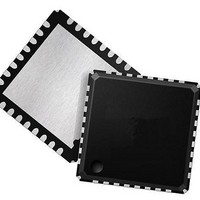LAN88710BM_samples SMSC, LAN88710BM_samples Datasheet - Page 27

LAN88710BM_samples
Manufacturer Part Number
LAN88710BM_samples
Description
Ethernet ICs MII/RMII 10/100 Automot Transceiver
Manufacturer
SMSC
Datasheet
1.LAN88710BM_SAMPLES.pdf
(80 pages)
Specifications of LAN88710BM_samples
Ethernet Connection Type
10BASE-T, 100BASE-TX
Minimum Operating Temperature
- 40 C
Mounting Style
SMD/SMT
Product
Ethernet Transceivers
Standard Supported
IEEE802.3, IEEE802.3u
Supply Voltage (max)
3.6 V
Supply Voltage (min)
1.6 V
Maximum Operating Temperature
+ 105 C
Package / Case
QFN-32
Lead Free Status / RoHS Status
Lead free / RoHS Compliant
Small Footprint MII/RMII 10/100 Ethernet Transceiver for Automotive Applications
Datasheet
SMSC LAN88710AM/LAN88710BM
3.1.4
3.1.4.1
3.1.4.2
3.1.4.3
3.1.4.4
10BASE-T Receive
The 10BASE-T receiver gets the Manchester- encoded analog signal from the cable via the magnetics.
It recovers the receive clock from the signal and uses this clock to recover the NRZI data stream. This
10M serial data is converted to 4-bit data nibbles which are passed to the controller via MII at a rate
of 2.5 MHz.
This 10M receiver uses the following blocks:
10M Receive Input and Squelch
The Manchester signal from the cable is fed into the transceiver (on inputs RXP and RXN) via 1:1 ratio
magnetics. It is first filtered to reduce any out-of-band noise. It then passes through a SQUELCH
circuit. The SQUELCH is a set of amplitude and timing comparators that normally reject differential
voltage levels below 300 mV and detect and recognize differential voltages above 585 mV.
Manchester Decoding
The output of the SQUELCH goes to the 10M RX block where it is validated as Manchester encoded
data. The polarity of the signal is also checked. If the polarity is reversed (local RXP is connected to
RXN of the remote partner and vice versa), the condition is identified and corrected. The reversed
condition is indicated by the
is locked onto the received Manchester signal, from which the 20MHz cock is generated. Using this
clock, the Manchester encoded data is extracted and converted to a 10 MHz NRZI data stream. It is
then converted from serial to 4-bit wide parallel data.
The 10M RX block also detects valid 10BASE-T IDLE signals - Normal Link Pulses (NLPs) - to
maintain the link.
10M Receive Data Across the MII/RMII Interface
For MII, the 4-bit data nibbles are sent to the MII block. In MII mode, these data nibbles are valid on
the rising edge of the 2.5 MHz RXCLK.
For RMII, the 2-bit data nibbles are sent to the RMII block. In RMII mode, these data nibbles are valid
on the rising edge of the RMII REF_CLK.
Jabber Detection
Jabber is a condition in which a station transmits for a period of time longer than the maximum
permissible packet length, usually due to a fault condition, which results in holding the TXEN input for
a long period. Special logic is used to detect the jabber state and abort the transmission to the line
within 45 ms. Once TXEN is deasserted, the logic resets the jabber condition.
As shown in
jabber condition was detected.
Filter and SQUELCH (analog)
10M PLL (analog)
RX 10M (digital)
MII (digital)
Section 4.2.2, "Basic Status Register," on page
XPOL
DATASHEET
bit of the
27
Special Control/Status Indications
55, the
Jabber Detect
Register. The 10M PLL
Revision 1.1 (05-26-10)
bit indicates that a












